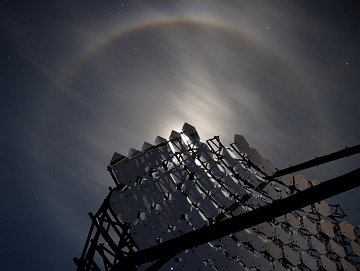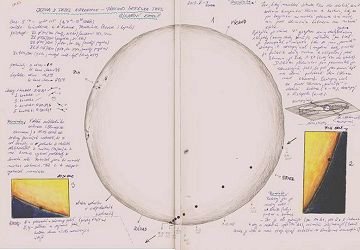 Autumn is here, and it's a wonderful time for stargazing. Find out what's up from Spaceweather PHONE.
Autumn is here, and it's a wonderful time for stargazing. Find out what's up from Spaceweather PHONE.
FIRST LIGHT FOR HINODE: A new space telescope onboard Japan's Hinode spacecraft is beaming back fantastic images of the sun. Get the full story from Science@NASA.
MOON HALO: When the Moon is big and bright, as it is tonight, keep an eye out for Moon halos. Gil Esquerdo of the Whipple Observatory on Mt. Hopkins, Arizona, saw this one last night:

"The 10-meter gamma ray telescope here at the observatory served as a Moon-block and a nice foreground," he says.
What made the halo? Answer: Ice crystals in high wispy clouds. ("The clouds that made the halo, also made observing a bit difficult" laments Esquerdo.) Circular halos are just one of many luminous shapes that may appear when icy clouds float overhead on a moonlit night. When you spot a moon halo, be alert for moondogs, pillars and tangent arcs as well.
TRANSIT OF MERCURY: Can a little black dot be an objet d'art? It can when the black dot is Mercury crossing the face of the sun:

"I made this pencil and pastel drawing three years ago during the May 7, 2003, transit of Mercury," says Petr Horalek of Pardubice, Czech Republic. "It was amazing to see that little point on the sun."
Another transit is just around the corner--next week on Nov. 8th. Sharpen your pastels!
Transit of Mercury Photo & Art Contest

